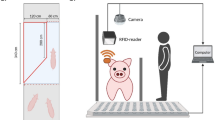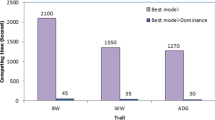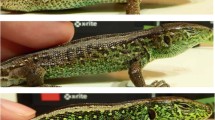Abstract
Heritabilities for two body weights and five antler characteristics were estimated for a captive white-tailed deer (Odocoileus virginianus) herd maintained by the Texas Parks and Wildlife Department. Single male breeding pens with 10–14 female deer were used for five consecutive generations. To minimize selection and maintain a broad genetic base, different sets of sires and as many different dams as possible were randomly assigned as breeders each generation. All deer were accurately predigreed by sire and dam and, except for birth weight, traits were measured at 1.5 years of age. Heritabilities were estimated utilizing (1) sire and within-sire components of variance, and (2) regression of male progeny performance on sire performance. Theoretically, these procedures estimate the amount of additive genetic variance present in a population without indication of non-additive genetic (dominance and epistasis) and maternal effects. Heritabilities ranged from 0.00-0.17 (birth weight), 0.58-0.64 (body weight), 0.22-0.56 (antler points), 0.47-0.70 (main beam length), 0.03-0.43 (antler spread), 0.80-0.89 (basal circumference) and 0.71-0.86 (antler weight). These heritabilities, except for birth weight, suggest that substantial genetic change could be expected from individual selection if realistic selection differentials were used.
Similar content being viewed by others
Article PDF
References
Ballinger, S W, Blankenship, L H, Bickham, J W, and Carr, S M. 1992. Allozyme and mitochondrial DNA analysis of a hybrid zone between white-tailed and mule deer in West Texas. Biochem Genet, 30, 1–11.
Becker, W A. 1984. Manual of Quantitative Genetics, 4th edn. Academic Enterprises, Pullman, WA.
Breshears, D D, Smith, M H, Cothran, E G, and Johns, P E. 1988. Genetic variability in white-tailed deer. Heredity, 60, 139–146.
Carr, S M, Ballinger, S W, Derr, J N, Blankenship, L H, and Bickham, J W. 1986. Mitochondrial DNA analysis of hybridization between sympatric white-tailed deer and mule deer in West Texas. Proc Natl Acad Sci USA, 83, 9576–9580.
Chesser, R K, and Smith, M H. 1987. Relationship of genetic variation to growth and reproduction in the white-tailed deer. In: Wemmer, C. (ed.) Biology and Management of the Cervidae, pp. 168–177. Smithsonian Institution Press, Washington, D.C.
Clutton-Brock, T H, Albon, S D, and Guinness, F E. 1989. Fitness costs of gestation and lactation in wild mammals. Nature, 337, 260–262.
Derr, J N. 1991. Genetic interactions between white-tailed and mule deer in the Southwestern United States. J Wildl Management, 55, 228–237.
Derr, J N, Hale, D W, Ellsworth, D L, and Bickham, J W. 1991. Fertility in an F1 male hybrid of white-tailed deer × mule deer. J Reprod Fert, 93, 111–117.
Falconer, D S. 1960. Introduction to Quantitative Genetics. Ronald Press, New York.
Gomendio, M, Clutton-Brock, T H, Albon, S D, Guinness, F E, and Simpson, M J. 1990. Mammalian sex ratios and variation in costs of rearing sons and daughters. Nature, 343, 261–263.
Harmel, D E, Williams, J D, and Armstrong, W E. 1989. Effects of genetics and nutrition on antler development and body size of white-tailed deer. Final Report, Texas Parks and Wildlife, Hunt, TX.
Johansson, I, and Rendel, J. 1968. Genetics and Animal Breeding. Freeman, San Francisco.
Lerner, I M. 1958. The Genetic Basis of Selection. Wiley, New York.
SAS Institute Inc. 1985. SAS User's Guide: Statistics, version 5. SAS Institute, Cary, NC.
Scribner, K T, and Smith, M H. 1990. Genetic variability and antler development. In: Bubenik, G. A. and Bubenik, A. B. (eds) Horns, Proghorns and Antlers, pp. 460–476. Springer, New York.
Scribner, K T, Smith, M H, and Johns, P E. 1984. Age, condition, and genetic effects on incidence of spike bucks. Proc Annu Conf Southeast Assoc Fish and Wildlife Agencies, 38, 23–32.
Scribner, K T, Smith, M H, and Johns, P E. 1989. Environmental and genetic components of antler growth in white-tailed deer. J Mammal, 70, 284–291.
Smith, M H, Chesser, R K, Cothran, E G, and Johns, P E. 1982. Genetic variability and antler growth in a natural population of white-tailed deer. In: Brown, R. D. (ed.) Antler Development in Cervidae, pp. 365–387. Caesar Kleberg Wildlife Research Institute, Kingsville, TX.
Smith, M H, Hillestad, H O, Manlove, M N, and Marchington, R L. 1976. Use of population genetics data for the management of fish and wildlife populations. Trans North Am Wildl Nat Resources Conf, 41, 119–133.
Smith, M H, Scribner, K T, Rhodes, O E, Jr, and Johns, P E. 1987. Genetics and antler development. Proc 18th Congr Int Union Game Biol, 1, 323–326. Swait Press, Krakow, Poland.
Templeton, J W, Sharp, R M, Williams, J D, Davis, D S, Harmel, D E, Armstrong, W E, and Wardroup, S E. 1982. Single dominant major gene effect on the expression of antler point number in the white-tailed deer. In: Brown, R. D. (ed), Antler Development in Cervidae, p. 469. Caesar Kleberg Wildlife Research Institute, Kingsville, TX.
Verme, L J, and Ullrey, D E. 1972. Feeding and nutrition of deer. In: The Digestive Physiology and Nutrition of Ruminants vol 3, Practical Nutrition, pp. 275–291. D.C. Church, Corvallis, OR.
Williams, J D, and Harmel, D E. 1984. Selection for antler points and body weight in white-tailed deer. Proc Annu Conf Southeast Assoc Fish and Wildlife Agencies, 38, 43–50.
Author information
Authors and Affiliations
Rights and permissions
About this article
Cite this article
Williams, J., Krueger, W. & Harmel, D. Heritabilities for antler characteristics and body weight in yearling white-tailed deer. Heredity 73, 78–83 (1994). https://doi.org/10.1038/hdy.1994.101
Received:
Issue date:
DOI: https://doi.org/10.1038/hdy.1994.101
Keywords
This article is cited by
-
Genomic architecture of phenotypic extremes in a wild cervid
BMC Genomics (2022)
-
Between-population differences in the genetic and maternal components of body mass in roe deer
BMC Evolutionary Biology (2018)
-
White-tailed Deer Management Strategies and Domestication Processes
Human Ecology (2011)
-
Heritability of body mass varies with age and season in wild bighorn sheep
Heredity (1999)
-
Environmental determination of a sexually selected trait
Nature (1999)



